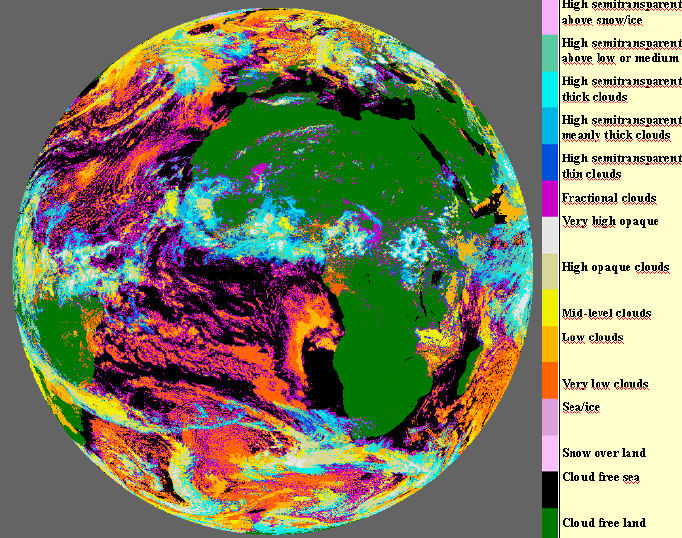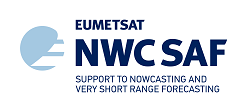
Cloud Type (GEO v2021)
Table of contents
1.- Goal of CT product
2.- CT algorithm summary description
3.- List of inputs for CT
4.- Coverage and resolution
5.- Description of CT outputs
6.- Example of CT visualisation
Access to "Algorithm Theroretical Basis Document for Cloud Products Processors of the NWC/GEO" for a more detailed description.
1. Goal of CT product
The cloud type (CT), developed within the SAF NWC context, mainly aims to support nowcasting applications. The main objective of this product is to provide a detailed cloud analysis.
It may be used as input to an objective meso-scale analysis (which in turn may feed a simple nowcasting scheme), as an intermediate product input to other products, or as a final image product for display at a forecaster 's desk. The CT product is essential for the generation of the cloud top temperature and height product and for the identification of precipitation clouds. Finally, it is also essential for the computation of radiative fluxes over sea or land, which are SAF Ocean & Sea Ice products.
The CT product therefore contains information on the major cloud classes : fractional clouds, semitransparent clouds, high, medium and low clouds (including fog) for all the pixels identified as cloudy in a scene. A second priority (not implemented in the current version) is the distinction between convective and stratiform clouds.
2. CT algorithm summary description
The CT algorithm is a threshold algorithm applied at the pixel scale, based on the use of CMA and spectral & textural features computed from the multispectral satellite images and compared with a set of thresholds.
The set of thresholds to be applied depends mainly on the illumination conditions, whereas the values of the thresholds themselves may depend on the illumination, the viewing geometry, the geographical location and NWP data describing the water vapour content and a coarse vertical structure of the atmosphere.
The CT classification algorithm is based on the following approach:
- Main cloud types are separable within two sets: the fractional and high semitransparent clouds, from the low/medium/high clouds. These two systems are distinguished using spectral features : T10.8µm-T12.0µm, T3.8µm-T10.8µm (in night-time conditions only), R0.6µm and R1.38µm (in day-time conditions only), and textural features (variance T10.8µm coupled to variance R0.6µm in daytime conditions) .
- Within the first set, the fractional and high semitransparent are separated mainly using their T8.7µm-T10.8µm brightness temperature differences, but also their R0.6µm visible reflectance (in daytime conditions only).
- The remaining categories are distinguished through the comparison of their T10.8µm to NWP forecast temperatures at several pressure levels. T7.3µm and T8.7µm are also used to refine the separation between low and medium clouds, especially useful in case of low level thermal inversion.
- No separation between cumuliform and stratiform clouds is performed in the current version of CT.
Some details on the tests are given in the Algorithm Theoretical Basis Document, that can be downloaded from this web page.
3. List of inputs for CT
Mandatory inputs are flagged, whereas the impact of missing non-mandatory data on the processing are indicated.
Satellite imagery
The following bi-directional reflectances or brightness temperatures are needed at full IR spatial resolution:
| R0.6µm | 1.38µm | T3.8µm | T7.3µm | T8.7µm | T10.4µm | T10.8µm | T12.0µm |
| Mandatory | | Mandatory | | | | Mandatory | Mandatory |
The CT software checks the availability of satellite channels for each pixel; no results are available for pixels where at least one mandatory channel is missing.
The channels are input by the user in HRIT format (or netcdf format for foreign satellites), and extracted on the processed region by NWC/GEO software package.
CMa cloud categories
The CMA cloud categories are mandatory. They are computed by the CMa software.
Sun and satellite angles
This information is mandatory. It is computed by the CT software itself, using the definition of the region and the satellite characteristics.
NWP parameters
The forecast fields of the following parameters, remapped onto satellite images, are used as input :
- surface temperatures
- air temperature at 950hPa (alternatively 925hPa) (to check low level inversion), 850hPa, 700hPa, 500hPa and at tropopause level
- total water vapour content of the atmosphere
- altitude of the NWP model grid (alternatively surface geopotential of the NWP model grid). Required if NWP fields are used as input.
These remapped fields are elaborated by the SAFNWC software package from the NWP fields input by the user in GRIB format.
The NWP fields are not mandatory. The CT software replaces missing NWP surface temperatures, air temperature at 850hPa, 700hPa, 500hPa or total water vapour content of the atmosphere by climatological values extracted from ancillary dataset. An alternative method is used in case of missing NWP air temperature at tropopause level. The quality of CT is lower if some NWP fields are missing.
Ancillary data sets
The following ancillary data, remapped onto satellite images, are mandatory :
- Land/sea atlas
- Elevation atlas
- Monthly minimum SST climatology
- Monthly mean 0.6µm atmospheric-corrected reflectance climatology (land)
- Monthly integrated atmospheric water vapor content climatology
- Monthly climatology of mean air temperature at 1000hPa, 850hPa, 700hPa, 500hPa.
These ancillary data are available in the NWC/GEO software package at a global scale; they are remapped on the satellite full disk by NWC/GEO remapping functionality.
One coefficients's file (also called threshold table), containing satellite-dependent values and look-up tables for thresholds, is available in the NWC/GEO software package, and is needed by the CT software.
4. Coverage and resolution
The CT software has been designed to allow the processing at satellite IR full spatial resolution of any rectangular areas defined by the user inside the full disk (the processing of the full disk is also possible). The validity of the CT product is commited on the satellite full disk.
5. Description of CT outputs
CT products are coded in NetCdF format and include:
Cloud type categories
| 0 | non-processed | containing no data or corrupted data |
| 1 | cloud free land | no contamination by snow/ice covered surface, no contamination by clouds; but contamination by thin dust/volcanic clouds not checked |
| 2 | cloud free sea | no contamination by snow/ice covered surface, no contamination by clouds; but contamination by thin dust/volcanic clouds not checked |
| 3 | land contaminated by snow | |
| 4 | sea contaminated by snow/ice | |
| 5 | very low clouds | |
| 6 | low clouds | |
| 7 | mid-level clouds | |
| 8 | high clouds | |
| 9 | very high clouds | |
| 10 | fractional clouds | |
| 11 | high semitransparent thin clouds | |
| 12 | high semitransparent meanly thick clouds | |
| 13 | high semitransparent thick clouds | |
| 14 | high semitransparent above low or medium clouds | |
| 15 | high semitransparent above snow/ice | |
Multilayer cloud flag
| FillValue | non-processed | containing no data or corrupted data |
| 0 | no multilayer detected | |
| 1 | multilayer detected | |
| 2 | cloud free | |
| 3 | undefined | separability problem |
6.Example of visualization
It is important to note that the CT product is not just images, but numerical data. At first hand, the CT is rather thought to be used digitally (together with the appended flags (quality) as input to mesoscale analysis models, objective Nowcasting schemes, but also in the extraction of other SAFNWC products (CTTH for example)).
Colour palettes are included in CT NetCdF files, thus allowing an easy visualisation of CT categories as illustrated on the SEVIRI CT example.
The user may be interested in visualising all the available classes as displayed on the CT example, or highlight one or a few categories suitable for the application of interest. Product's animation will be a help for the user to interpret the visualized CT, and to identify artefacts (for example, the replacement of a snowy area by a low cloud between two successive pictures may be due only to the transition from day to night, as the snow detection is not possible at nighttime).
Click on thumbnail for full-size this image
Example of CT using the colour palette included in CT NetCdF files.
